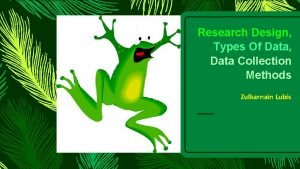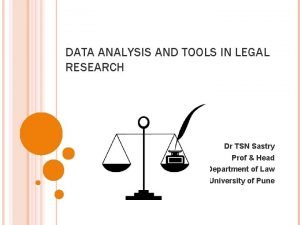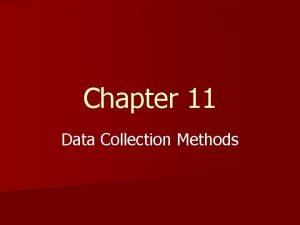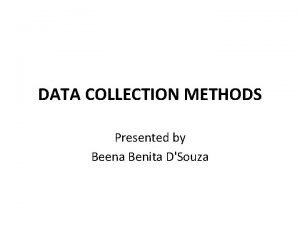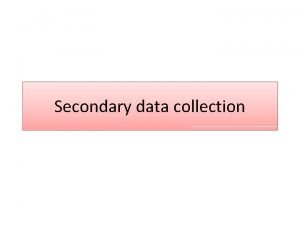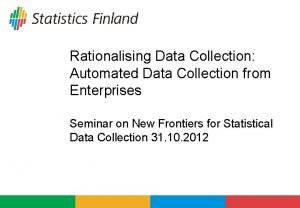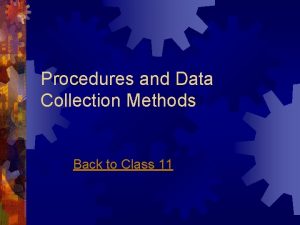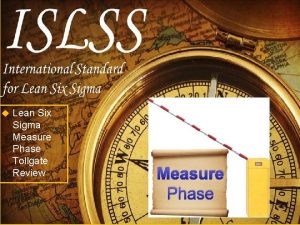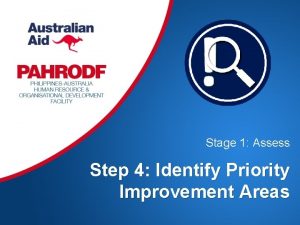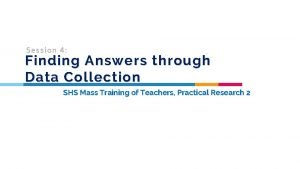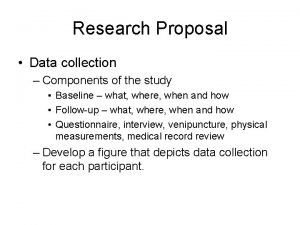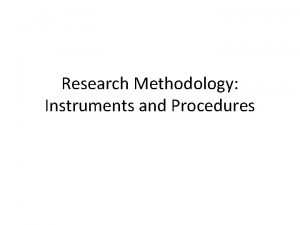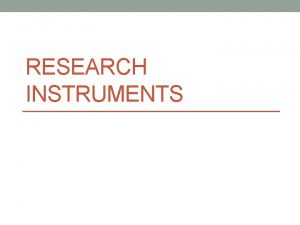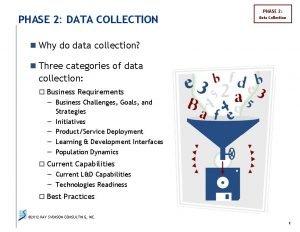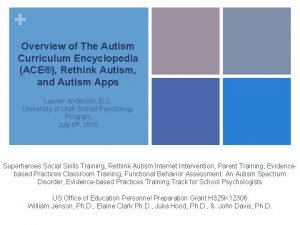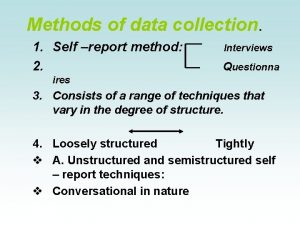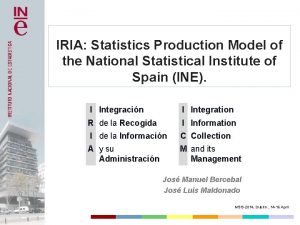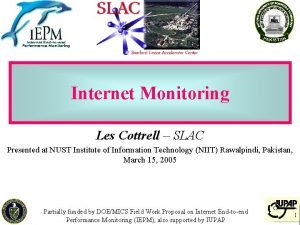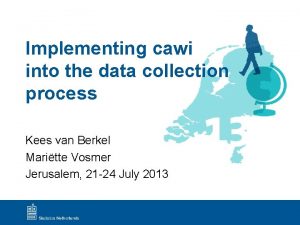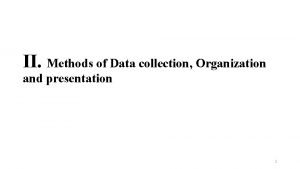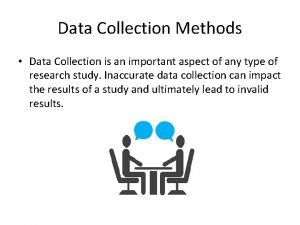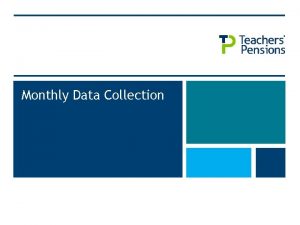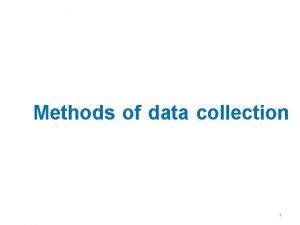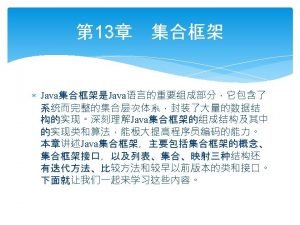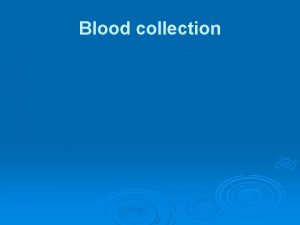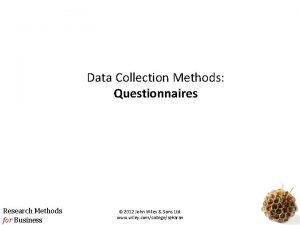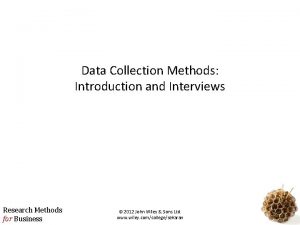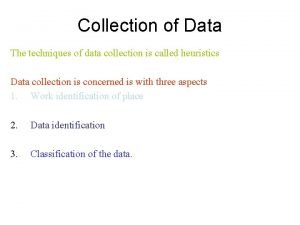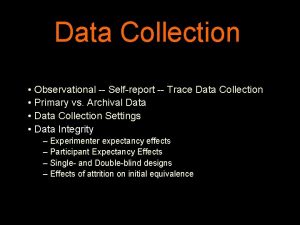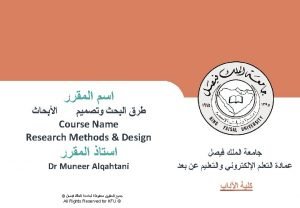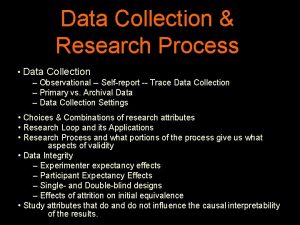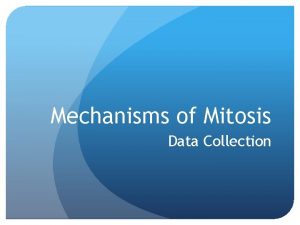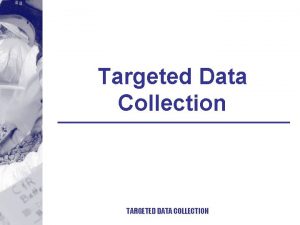Data Collection Methods o Methods of data collection




























- Slides: 28

Data Collection Methods

o Methods of data collection: n n Questionnaires Interviews Observations Physiological and psychological measures

o Questionnaires: n Is a paper and pencil, self report instrument n Purposes: to measure knowledge levels, opinions, attitudes, beliefs, ideas, feelings, and perceptions and factual information about respondents

o A questionnaire in influenced by: n The overall appearance n Language and reading level of questions n Length of questionnaire and questions

Advantages/disadvantages of questionnaires Advantages Disadvantages Quick and inexpensive Mailing may be costly Less time consuming than interviews and observation May provide socially acceptable answers Can obtain data from geographically widespread areas Low response rate Easiest to test for reliability and validity of instrument May fail to respond to some items

Advantages/disadvantages of questionnaires Anonymity of participants No opportunity to clarify misunderstood items Provide honest answers because of its anonymity Need literate respondents Respondents must have no physical disabilities Respondents may not be representative of population

o Interviews: Face to face n Telephone interview n

o Types of interviews: Structured n Unstructured n Semi structured n

o Influence of interviewers on respondents: n In face to face interviews, non experimental research it is called Rosenthal effect n In experimental research it is called experimental effect

Advantages/disadvantages of interviews Advantages Disadvantages Reponses can be obtained from a wide range of subjects Need training for interviewers Response rate is high Time consuming and expensive Data obtained is usable Need arrangement Provide In-depth responses Respondents may produce socially acceptable responses

Advantages/disadvantages of interviews Non verbal and verbal mannerisms can be observed Subjects may be anxious/ due to recording Subjects may be influenced by interviewers characteristics Interviewers may misinterpret nonverbal behavior

o Observation Methods: Gathering data through visual observation n Structured (Checklist) and unstructured observations n Interrater reliability n

o Relationship between observer and subjects: n Non participant observer- overt n Non participant observer- covert n Participant observer- covert

o Physiologic measures: collection of physical data from subjects o They are more objective and accurate o Example: measuring BP , ECG

o Attitude scales: Self report data collection instruments that ask respondents to report their attitudes or feelings on a continuum n Types: p Likert p scale: SD D U A Semantic: Friendly ---- ---unfriendly SA

o Psychological tests: personality inventories

o Visual Analog Scale: A straight line that represent extremes of a phenomenon Pain 0 -------------------100 mm n Can be a horizontal or vertical line

o Pre existing data; Using data that is available and that has not been collected for research purposes, patients’ records

o attitude scales n Self-report data collection instruments that ask respondents to report their attitudes or feelings on a continuum. o close-ended questions n Questions that require respondents to choose from given alternatives. o contingency questions n Questions that are relevant for some respondents and not for others.

o Delphi technique A data collection method that uses several rounds of questions to seek a consensus on a particular topic from a group of experts on the topic. o demographic questions n Questions that gather data on characteristics of the subjects (see demographic variables). o demographic variables n Subject characteristics such as age, educational levels, and marital status. o double-barreled questions n Questions that ask two questions in one. n

o Likert scale n An attitude scale named after its developer, Rensis Likert. These scales usually contain five or seven responses for each item, ranging from "strongly agree" to "strongly disagree. " o nonparticipant observer-covert n Research observer does not identify herself or himself to the subjects who are being observed. o nonparticipant observer-overt n Research observer openly identifies that she or he is conducting research and provides subjects with information about the type of data that will be collected.

o observation research n A data-collection method in which data are collected through visual observations. o open-ended questions n Questions that allow respondents to answer in their own words. o participant observer-covert n Research observer interacts with subjects and observes their behavior without their knowledge. o participant observer-overt n Research observer interacts with subjects openly and with the full awareness of those people who will be observed.

o personality inventories Self-report measures used to assess the differences in personality traits, needs, or values of people. o preexisting data n Existing information that has not been collected for research purposes. o probes n Prompting questions that encourage the respondent to elaborate on the topic that is being discussed. n o

o Projective technique n Self-report measure in which a subject is asked to respond to stimuli that are designed to be ambiguous or to have no definite meaning. The responses reflect the internal feelings of the subject that are projected on the external stimuli. o Q-sort (Q methodology) n A data-collection method in which subjects are asked to sort statements into categories according to their attitudes toward, or rating of, the statements.

o questionnaire A paper-and-pencil, self-report instrument used to gather data from subjects. o semantic differential n Attitude scale that asks subjects to indicate their position or attitude about some concept along a continuum between two adjectives or phrases that are presented in relation to the concept that is being measured. n

o semi structured interviews Interviewers ask a certain number of specific questions, but additional questions or probes are used at the discretion of the interviewer. o structured interviews n Interviewers ask the same questions in the same manner of all respondents. o structured observations n The researcher makes the determination of behaviors to be observed before data collection. Usually some kind of checklist is used to record behaviors. n

o telephone interviews n Data are collected from subjects through the use of phone calls rather than in faceto-face encounters. o unstructured interviews n The interviewer is given a great deal of freedom to direct the course of the interview; the interviewer's main goal is to encourage the respondent to talk freely about the topic that is being explored.

o unstructured observations The researcher describes behaviors as they are viewed, with no preconceived ideas of what will be seen. o visual analogue scale n Subjects are presented with a straight line that is anchored on each end with words or phrases that represent the extremes of some phenomenon, such as pain. Subjects are asked to make a mark on the line at the point that corresponds to their experience of the phenomenon. n
 Types of data collection methods
Types of data collection methods Data analysis in legal research
Data analysis in legal research Observational data collection methods
Observational data collection methods Data collection methods observation
Data collection methods observation Primary data means
Primary data means Automated data collection methods
Automated data collection methods Landsat collection 1 vs collection 2
Landsat collection 1 vs collection 2 Sightd
Sightd Collection methods and procedures
Collection methods and procedures Research procedure in methodology
Research procedure in methodology Data collection secondary data sources
Data collection secondary data sources Indirect wax pattern
Indirect wax pattern What is quantitative example
What is quantitative example Data collection planning in the measure phase starts with
Data collection planning in the measure phase starts with Priority improvement areas sample
Priority improvement areas sample Finding answer through data collection
Finding answer through data collection Sampoorna data collection format
Sampoorna data collection format Data gathering procedure in research proposal
Data gathering procedure in research proposal It is the part where you indicate the research instrument
It is the part where you indicate the research instrument Sample of research instrument
Sample of research instrument Define data collection method
Define data collection method Data collection phase
Data collection phase Rethink autism for parents
Rethink autism for parents Interview method of data collection
Interview method of data collection Self-report method
Self-report method Iria data collection
Iria data collection Network data collection at slac
Network data collection at slac Cawi data collection
Cawi data collection Methods of data organization and presentation
Methods of data organization and presentation
